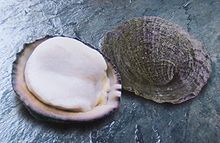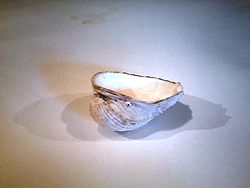- Concholepas concholepas
-
Concholepas concholepas 
Two live individuals of Concholepas concholepas; the one on the left has been turned over to show the underside of the large muscular foot Scientific classification Kingdom: Animalia Phylum: Mollusca Class: Gastropoda (unranked): clade Caenogastropoda
clade Hypsogastropoda
clade NeogastropodaSuperfamily: Muricoidea Family: Muricidae Subfamily: Rapaninae Genus: Concholepas Species: C. concholepas Binomial name Concholepas concholepas
(Bruguière, 1789)Subspecies C. concholepas fernandezianus
Range of C. concholepas Synonyms[1] Buccinum concholepas Bruguière, 1789 (basionym)
Concholepas decipiens Mabille, 1886
Concholepas densestriatus Mabille, 1886
Concholepas granosus Mabille, 1886
Concholepas imbricatus Valenciennes, 1832
Concholepas laevigatus Valenciennes, 1832
Concholepas minor Mabille, 1886
Concholepas oblongus Reeve, 1863
Concholepas patagonicus Mabille, 1886
Concholepas peruviana Lamarck, 1801
Concholepas rhombicus Mabille, 1886
Concholepas similis Mabille, 1886
Concholepas splendens Mabille, 1886
Concholepas verucundus Mabille, 1886
Murex locus Molina, 1792
Patella lepas Gmelin, 1791
Purpura loca d'Orbigny, 1846
Purpura pileopsis Blainville, 1832Concholepas concholepas, common names the Chilean abalone, loco (Chilean Spanish a loanword from Mapudungun[2]) or pata de burro and chanque (Peruvian Spanish), is a species of large edible sea snail, a marine gastropod mollusk. Despite the superficial resemblance, C. concholepas is not a true abalone (a species in the family Haliotidae), but a member of the family Muricidae, also known as murex snails or rock snails. This species is native to the coasts of Chile and Peru.
Due to overfishing, in Chile the harvesting of this species has been limited by law since 1989.
The blue blood of this species contains hemocyanin, which is being investigated as a treatment for bladder and prostate cancer.[3]
Contents
Shell description
C. concholepas has a thick, slightly oval and white-brown to purple grey shell. Its very few whorls makes it resemble a Phrygian cap in shape. The outer surface of the shell shows strong lamellose ribs of which there are both radial and circular-concentric ones.
The shell is shaped almost like that of an abalone, with a very large aperture compared to other muricids. A loco cannot hide completely inside the shell if it is turned upside down, and has therefore no need of its operculum; instead it relies on its strong foot to remain in place. The shell is made of calcite with an inner layer of aragonite.[4]
The shells of this species are used as ashtrays in Chile.
Ecology
Habitat and distribution
C. concholepas is a benthic predator that lives on rocks in temperate waters from sea levels down to depths of 40 m.[5] Its diet consists of Mytilids (such as Semimytilus algosus and Perumytilus purpuratus) and barnacles (such as Chthamalus scabrosus).[6]
Its geographic distribution ranges from Lobos de Afuera in Peru, to Cape Horn in Chile, including the Juan Fernández Islands.[7]
Life cycle
C. concholepas is dioecious, which means that the populations are divided between male and females, though there are no external evidences of sexual dimorphism. The fertilisation in this species occurs internally.[8] In central Chile females lay egg capsules on low intertidal and shallow subtidal rocky surfaces during austral fall months. After around one month of development inside the capsules, small planktotrophic veliger larva (2.6 mm) are released. The larvae spend the following three months in the water column and once they become competent, they dwell at the sea surface until they settle on rocky intertidal and shallow subtidal habitats down to 30 m.[5] The normal size at which the snail reaches sexual maturity is between 5.4 and 6.7 cm; it takes about 4 years to reach this size.[9]
Human uses
C. concholepas is used in Chilean cuisine and is commercially marketed worldwide as a delicacy - misleadingly under the name "Chilean abalone". (True abalones are primitive herbivores whereas Concholepas concholepas is a muricid, a sophisticated carnivore). Its economic value and ecological importance as top predator have made the loco the most studied marine invertebrate species in Chile.[10]
Commercial fishery
On the Chilean coast, C. concholepas is one of the most important edible mollusc species and is a major product of the aquacultural industry.[11] In 1975 about 5,000 tons were extracted annually. In 1980 the extraction peaked with a catch of 25,000 tons.[12] Since 1989 extraction is illegal in Chile but from 1992 onwards some exceptions have been made for accredited commercial divers. The minimum size allowed for extraction is 10 cm. Currently the only legal way for artisan fishermen or other people to catch locos is to have an "AMERB" (Spanish for Marine Area of Benthonic Resources Extraction). However even in these areas extraction is prohibited from December to July from Valparaíso Region northward and from January or February to July south of it. Populations have shrunk and a recent study shows that extraction is making an artificial selection to eliminate faster-growing individuals.[7][13] The same study also showed that populations in Chile are relatively homogeneous with low genetic variability. Due to over-extraction scientists have since 1986 studied the possibility of commercial cultivation.
Cuisine
In Chilean cuisine the meat of the foot of these snails is cooked and eaten with mayonnaise or as a chupe de locos soup in a earthenware bowl. The chupe de locos typically contains about 6 loco foots, 100 grams of a fatty cheese such as Chanco cheese, 2 eggs, 4 spoonful of grated bread, salt and paprika.[14]
Possible medical use
The hemocyanin found in the blood of C. concholepas has immunotherapeutic effects against bladder and prostate cancer. In 2006 research mice were primed with C. concholepas before implantation of bladder tumor (MBT-2) cells. Mice treated with C. concholepas showed a significant anti-tumor effect. The effects included prolonged survival, decreased tumor growth and incidence and lack of toxic effects.[3]
Other possible scientific uses
C. concholepas shells are a potential proxy-bearer for climate change studies. There are many fossil shell accumulations in Pleistocene coastal terraces. Climate indicators are, by far, less abundant for ancient cold seas; therefore, investigating the ability of C. concholepas will provide valuable signals for long-term evolution of the sea surface temperatures in cold seas, and might be important in reconstructing the El Niño Southern Oscillation (ENSO) history.[11]
References
- ^ Houart, R. (2009). "World Register of Marine Species". Concholepas concholepas (Bruguière, 1789). http://www.marinespecies.org/aphia.php?p=taxdetails&id=395353. Retrieved 23 March 2010.
- ^ (Spanish) Etimología de LOCO. Etimologías de Chile
- ^ a b Moltedo, B.; et al (2006). "Immunotherapeutic effect of concholepas hemocyanin in the murine bladder cancer model : Evidence for conserved antitumor properties among hemocyanins". The Journal of Urology 176 (1): 2690–2695. doi:10.1016/j.juro.2006.07.136. ISSN 0022-5347. PMID 17085197. http://cat.inist.fr/?aModele=afficheN&cpsidt=18281377.
- ^ Guzmán, N.; et al (2009). "Diagenetic changes in Concholepas concholepas shells (Gastropoda, Muricidae) in the hyper-arid conditions of Northern Chile – implications for palaeoenvironmental reconstructions". Biogeosciences 6 (2): 197–207. doi:10.5194/bg-6-197-2009. http://www.biogeosciences.net/6/197/2009/bg-6-197-2009.pdf.
- ^ a b Poulin, E.; et al (2002). "Avoiding offshore transport of competent larvae during upwelling events: The case of the gastropod Concholepas concholepas in Central Chile". Limnology and Oceanography (American Society of Limnology and Oceanography, Inc.) 47 (4): 1248–1255. doi:10.4319/lo.2002.47.4.1248. ISSN 0024-3590. http://www.bio.puc.cl/caseb/casebpdf/Poulin%20et%20al.2002b.Limn&Ocean.pdf.
- ^ Dye, A. H. (1991). "Feed preferences of Nucella crassilabrum and juvenile Concholepas concholepas (Gastropoda: Muricidae) from a rocky shore in Southern Chile". Journal of Molluscan Studies (Oxford Press) 57 (3): 301–307. doi:10.1093/mollus/57.3.301. ISSN 1464-3766. http://mollus.oxfordjournals.org/cgi/content/abstract/57/3/301.
- ^ a b (Spanish)[1] Catastro genético de locos y erizos del litoral chileno. Ministerio de Agricultura, Gobierno de Chile
- ^ Ramorino, L. M. (1975). "Ciclo reproductivo de Concholepas concholepas en la zona de Valparaíso" (in Spanish). Revista de Biología Marina 15 (2): 149–177. http://www.revbiolmar.cl/escaneados/152-149%20%28Parte%201%29.pdf.
- ^ Zagal, R.; Hermosilla, C. (2001) (in Spanish). Guía de Invertebrados Marinos del Litoral Valdiviano (1 ed.). Santiago, Chile: Ediciones Quebecor World Chile S. A.. pp. 219. ISBN 9789562889742.
- ^ Castilla 1988
- ^ a b Guzman, N.; et al (2007). "Subdaily Growth Patterns and Organo-Mineral Nanostructure of the Growth Layers in the Calcitic Prisms of the Shell of Concholepas concholepas Bruguière, 1789 (Gastropoda, Muricidae)". Microscopy and Microanalysis (Cambridge University Press) 15 (3): 397–403. http://journals.cambridge.org/action/displayAbstract?fromPage=online&aid=1357576.
- ^ (Spanish)[2] Las áreas de manejo en la Ley de Pesca y Acuicultura: Primeras experiencias Evaluación de la utilidad de desta herramienta para el recurso Loco
- ^ "Cultivo del recurso loco (Concholepas concholepas) como alternativa de abastecimento de materia prima para la industria procesadora de recursos hidrobiologicos". Octavio Concurso Nacional de Proyectos de I+D FONDEF. Fondef. http://www.fondef.cl/bases/fondef/PROYECTO/00/I/D00I1019.HTML. Retrieved 21 June 2010.
- ^ "Chupe de Locos". Recetas Patagónicas. http://www.interpatagonia.com/recetas/chupedelocos/. Retrieved 21 June 2010.
Sources
- (Spanish) Fishing resources database
Edible mollusks Bivalves Atlantic jackknife • Atlantic surf • Geoduck • Grooved carpet shell • Hard clam • Horse • Mactra stultorum • Blunt gaper • Ocean quahog • Pacific razor • Pecten jacobaeus • Venus • California butterclam • Senilia senilis • Smooth clam • Soft-shell • Triangle shell • Tuatua • Japanese littleneck • Razor clam • Pod razor • Ensis (razor genus) • PaphiesBlue • Mediterranean • New Zealand green-lipped • California • Brown • Asian/Philippine green • Date • Mytilidae (mussel family)Auckland • Eastern • Olympia • Southern mud • Colchester native • Pacific • Portuguese • Windowpane • Rock • Sydney rock • Ostra chilena/Bluff • Gillardeau oysters • Crassostrea ("true oyster" genus)Gastropods Queen • DogBlack foot opihi/Haiwaiian • China • Common European • Rayed Mediterranean • Ribbed Mediterranean • Rustic • Turtle/Talc • Yellow foot opihiLandFreshwaterNeritesInkfish Spineless • BottletailChitons Chiton magnificus • Acanthopleura granulataRelated topics: Oyster farming • Land snail farming • Categories:- Muricidae
- Edible molluscs
- Commercial molluscs
Wikimedia Foundation. 2010.



